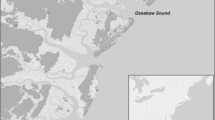Abstract
The survey and mapping group (SMG) of Statoil is responsible for all seafloor mapping for pipelines and field development in Statoil. During numerous reconnaissance and pipeline route surveys over large portions of our contintental shelf, in the North, Norwegian and Barents Seas, we have only detected deep-water coral reefs in a few specific areas. The first reef we found was in 1982, using a combined side scan sonar and sub-bottom profiler system off Fugløy, northern-Norway. Thereafter, numerous reefs were mapped with similar systems off mid-Norway, during the period 1985–1990 for the reconnaissance and final route mapping of the Haltenpipe project. During 1997, we also mapped some previously known reefs in the Trondheimsfjord area while surveying a route for the Tjeldbergodden - Skogn pipeline project. Between 1997 and 2000, we have mapped more reefs along pipeline routes on the outer mid-Norway continental shelf. These reefs are of a smaller size (less than 5 m high) than those mentioned above (5–31 m high). Although side scan sonar and sub-bottom profilers provide a less ambiguous detection of reefs, we have found that modern multi-beam echosounder data can provide adequate remotely sensed data for deep-water coral reef mapping. The interpretation of the reefs is based on visual documentation by ROV (remotely operated vehicle) or by sampling with gravity corers and grabs (ground-truthing). Based on a limited amount of such ground-truthing, it has been possible to extrapolate and use the specific morphological characteristics of the reefs to map their density and distribution. For the Haltenpipe project, we mapped an offshore route corridor of about 200 km length at a width of 3 km with multi-beam echosounder. On the basis of ground-truthing 14 of the suspected coral reefs, we have found the total number of reefs to be 57 within the 600 km2 mapped area. All these reefs are higher than 5 m (the highest is 31 m) and of diameters at their base of more than 50 m. Although they occur in local clusters with up to 10 reefs per km2, the mean density of reefs along the entire (200 km long) transect is only 0.09 suspected reefs per km2. However, there is a large regional density variation, with the highest regional density being 1.2 reefs per km2 in an area of subcropping Palaeocene sedimentary rocks. A brief discussion of why the corals have constructed their reefs in the deep, cool, and generally `hostile' waters of the Norwegian continental shelf and fjords concludes with them probably subsisting on a reliable and steady nutrient source, independent of season and variations in the Atlantic Drift (`Gulf stream'). This positive environmental component is called `hydraulically active substrata'. It is thus speculated that micro-organisms, bacteria etc., utilizing the hydraulically activated chemical porewater gradients, cause a local enrichment on which the cnidarian organisms ultimately depend.
Similar content being viewed by others
References
Bates, R. L. & J. A. Jackson, 1987. Glossary of Geology. Third ed., Am. Geol. Inst., Alexandria, Virginia, U.S.A.: 565 pp.
Bugge, T., R. Knarud & A. Mørk, 1984. Bedrock geology on the mid-Norwegian continental shelf. In Spencer, A. M. (ed.), Petroleum Geology of the North European Margin. Norwegian Petoleum Society, Graham & Trotman Ltd., London: 271–283.
Dons, C., 1944. Norges korallrev. Norske Videnskabers Selskabs Forhandlinger, Trondheim, 16A: 37–82.
Fosså, J. H. & P. B. Mortensen, 1998. Artsmangfoldet på Lophelia korallrev og metoder for kartlegging og overvåkning. Fisken og havet,17: 95 pp.
Frederiksen, R., A. Jensen & H. Westerberg 1992. The Distribution of the scleractinian coral Lophelia pertusa around the Faroe islands and the relation to internal tidal mixing. Sarsia 77: 157–171.
Freiwald, A., 1995. Deep-water coral reef mounds on the Sula-Ridge, mid-Norway Shelf. Field report Cruise 24/95 Report, R/V Victor Hensen. Universit #x00E4;t Bremen: 13 pp.
Freiwald, A., R. Henrich & J. Pätzold, 1997. Anatomy of a deep-water coral reef mound from Stjernsund, west Finnmark, northern Norway. In James, N. P. & J. A. D. Clarke (eds), Cool-Water Carbonates. Society of Sedimentary Geologists (SEPM). Special Publ. 56: 140–161.
Gooday, A. J., L. A. Levin, P. Linke & T. Heeger, 1992. The role of benthic foraminifera in deep-sea food webs and carbon cycling. In Rowe, G. T. & V. Patience (eds), Deep-Sea Food Chains and the Global Carbon Cycle. Kluwer Academic Publishers, Dordrecht: 63–91.
Henrich, R., A. Freiwald & the Shipboard Party, 1997. The Lophelia reef of Sula ridge, mid-Norwegian shelf. Cruise report No 228/97, Bremerhaven: 12 pp.
Hovland, M., 1990. Do carbonate reefs form due to fluid seepage? Terra Nova 2: 8–18.
Hovland, M. & A. Indreeide, 1980. Mapping the seafloor offshore west coast Norway. International Hydrographic Review 100: 154–162.
Hovland, M. & A. G. Judd, 1988. Seabed Pockmarks and Seepages. Impact on Geology, Biology and the Marine Environment. Graham & Trotman Ltd., London: 293 pp.
Hovland, M. & P. B. Mortensen, 1999. Norske korallrev og prosesser i havbunnen (Norwegian coral reefs and seabed processes), John Grieg, Bergen, Norway: 167 pp. (in Norwegian with English summary).
Hovland, M., P. B. Mortensen, T. Brattegard, P. Strass K. Rokoengen, 1998. Ahermatypic coral banks off mid-Norway: evidence for a link with seepage of light hydrocarbons. Palaios 13: 189–200.
Hovland, M. & E. Thomsen, 1997. Cold-water corals–are they hydrocarbon seep related? Mar. Geol. 137: 159–164.
Newton, C. R., H. T. Mullins, A. F. Gardulski, A. C. Hine & G. R. Dix, 1987. Coral mounds on the West Florida Slope: unanswered questions regarding the development of deep-water banks. Palaios 2: 359–367.
Rokoengen, K., L. Rise, P. Bryn, B. Frengstad, B. Gustavsen, E. Nygaard & J. Sættem, 1995. Upper Cenozoic stratigraphy on the Mid-Norwegian continental shelf. Norsk Geologisk Tidsskrift 75: 88–104.
Stetson, T. R., D. F. Squires & R. M. Pratt 1962. Coral banks occurring in deep water on the Blake Plateau. American Museum Novatites 2114: 1–39.
Author information
Authors and Affiliations
Rights and permissions
About this article
Cite this article
Hovland, M., Vasshus, S., Indreeide, A. et al. Mapping and imaging deep-sea coral reefs off Norway, 1982–2000. Hydrobiologia 471, 13–17 (2002). https://doi.org/10.1023/A:1016576514754
Issue Date:
DOI: https://doi.org/10.1023/A:1016576514754




